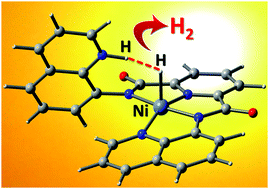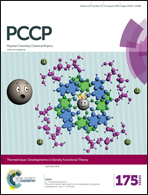Proton reduction by a nickel complex with an internal quinoline moiety for proton relay†
Abstract
The complex Ni(DQPD) (where DQPD = deprotonated N2,N6-di(quinolin-8-yl)pyridine-2,6-dicarboxamide (DQPDH2)) behaves as a visible light driven active catalyst to reduce protons from water when employed with the photosensitizer fluorescein (Fl) and triethylamine (TEA) as the sacrificial electron donor. The photocatalytic system shows very high activity, attaining 2160 turnovers and an initial turnover rate of 0.032 s−1 with respect to the catalyst. The proposed electrocatalytic mechanism is of the CECE type (C is a chemical step protonation and E is the electrochemical step reduction), where the Ni(DQPD) catalyst undergoes rapid protonation at the non-coordinating nitrogen atom of the quinoline before undergoing reduction. The location of the pendant base is a key factor such that the N–H resulting from the protonation of the non-coordinating nitrogen atom of the quinoline is properly located to interact with the Ni–H hydride leading to heterocoupling between protons and hydrides. Theoretical calculations for the catalytic system were carried out using the density functional level of theory (DFT) and are consistent with a mechanism for catalysis in a polypyridine nickel system. This is the first report of a polypyridine based nickel catalyst where the pendant base is responsible for the internal proton relay towards the metal center through the heterocoupling between protons and hydrides to generate hydrogen.


 Please wait while we load your content...
Please wait while we load your content...